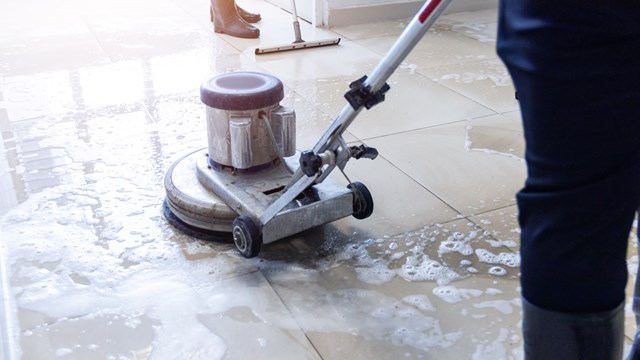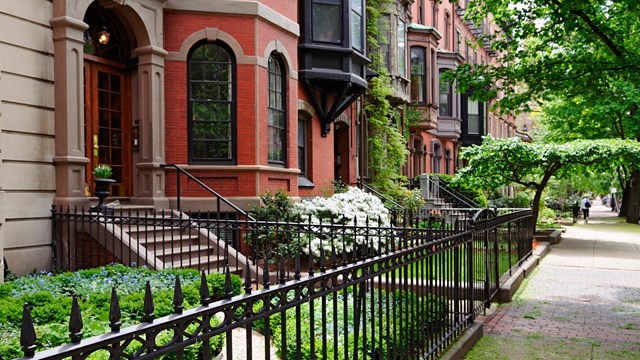
Condos and HOA communities can be a great setting to own a home, enjoy privacy and the comforts of your own personal space. But there will always be tension between the desire to make your unit your own, and adhering to the rules of the community for the greater good, which is usually peaceful coexistence and healthy property values.
One of the great examples of this conflict is outside space. Balconies, lawns, terraces, and backyards—these are the places where people are still in their homes, and also in a common area because they can all be seen by neighbors. Gardens, pools, and decorations—they reflect the appearance of the entire community, but they are an owner’s private property as well. Unit owners, property managers, and their attorneys need to navigate rules and stipulations that affect these areas with special care because of that inherent conflict of interest.
Limited Common Elements
To some people, a lawn or balcony might sound pretty uncontroversial. But, then again, everyone has seen how some people can go to extremes to personalize their outside spaces. “It is definitely subject to regulation by the association because it is part of the common areas. The common ones are decks, balconies, storage spaces sometimes, parking spaces, those are typically limited common areas, not always, but typically. Aside from the regulations that the board might establish, there’s the issue of who’s responsible to maintain. And that usually depends on what’s in the condominium documents,” says Janet Aronson, an attorney at the law firm of Marcus, Errico, Emmer & Brooks, P.C. in Braintree, Massachusetts.
Many people buy homes with the ideal in mind that a person’s or family’s home is their castle, their safe haven. Obviously, a condo unit can act as just that, but at the same time, a condo unit is not that same as a traditional single-family home. Often, people don’t truly appreciate the difference when they buy into a condo building or HOA. There can be strict guidelines for how the community as a whole operates, and how things look on the outside can be a source of the most restrictive rules.
“I think it creates confusion because people just consider it part of their unit. They use it exclusively, so they think it’s like their unit and that they control it, so therefore they should be able to do whatever they want with it — which is what creates I think, the confusion. I guess the important thing to really bear in mind is it’s really part of the common areas, but you exclusively use it, which is different than your unit that you own outright. The common areas are owned by all of the owners collectively, but you get the right to use this particular common area exclusively,” says Aronson.
State–by-State
How the rules are put forth depends on what state you live in. “In Massachusetts, it’s a little different than some other places. In Massachusetts, the board has the right to designate areas as limited common areas and regulate the use, but you need the permission of the adjoining owners and mortgage holders,” says Charles Perkins, an attorney at the law firm of Perkins & Anctil in Westford, Massachusetts.
But, in reality, associations tend to have the right to control the use and look of outside structures like balconies, backyards, and lawns. “Associations want to keep the limited common areas uniform and consistent. They don’t want them being painted different colors, or constructed in a different way. If they’re pressure-treated wood, then they want them all to be pressure-treated wood,” says Aronson. Since balconies and decks are technically common areas, albeit for exclusive use by a particular owner, their maintenance is usually the responsibility of the association. This gives boards of trustees all the more incentive to make sure the materials aren’t meddled with.
“I think the biggest issue is the maintenance responsibilities, because sometimes it’s not always clearly defined in the documents as to who should be responsible. In some associations, some people have decks and other units don’t. So that kind of creates the idea that, ‘Well, why should I be responsible for common expenses to fix a person’s deck when I don’t have one?’” says Aronson.
It’s important for property managers and boards to make rules like that crystal clear and easily accessible, so people don’t waste their time and money, and cause major issues for themselves and the community. While boards and management aren’t expected to walk the property every day and police decorations and exclusive common area use at all times, they do have make sure that, generally, the outdoor spaces look as they should. “You even find sometimes everybody thinking, the board thinking, that’s being a good guy, allowing somebody to put up a bird bath, and before you know it, you got three bird baths, wind chimes, and stuff all over the property. That’s a problem,” says Perkins.
It’s a difficult line to walk, because unit owners can wield a lot of power in the state’s legal system, namely when it comes to sensitive issues like religious expression. “You sometimes see people litigating over the ability to put certain things in the common area; religious artifacts, gardens, things of that nature. So you’ve got to be careful obviously with the religious artifacts because if it’s something related to someone’s religion, then you better be careful that you tell them what they can and they can’t use it for,” says Perkins.
While the list of common restrictions is long, there are a couple things that are protected by state and federal law. American flags are a common example. Federal law from the 1990s on over-the-air-reception devices also gives special exception to satellite dishes. “You can install satellite dishes or antennas in your limited common area. So, if you have a deck or balcony and you can get an acceptable signal, you have the right to install one there. I think that the limited common area is confusing because unit owners just feel that they own it and they control it, but that’s not necessarily the case. I think that’s the biggest misconception with it, and that creates problems,” says Aronson
What to Do About Gray Areas?
There are some pretty big gray areas as well. What if a tree, for instance, on one property hangs over and negatively affects another? “If it's a hedge and you have approached your neighbor, and said, ‘Look I'm going to have my landscaper cut it. Do you mind if they access your property or reach over with their tools to cut it?’ That should be step number one—is just to have good neighborly relations. If not that, if you and your neighbor can’t get along or don’t get along, you can also reach out to your association to see if there’s any procedures established. And then perhaps the association should establish procedures if none are established, because you’re landscaping and then what you plant on your side of the fence shouldn’t unreasonably interfere with your neighbor’s use of his property,” says Roberto Blanch, a community association attorney based in Florida.
How do all these decisions get made? The key to it all is how an association manages to enforce and protect such regulations and restrictions. “As with any restriction, they need to be reasonable. They need to be uniformly enforced. The association can’t be arbitrary in its enforcement of the rules promulgated as to that item. While some communities want to have a very sterile appearance and look the same, and owners tend to buy in the communities because of that uniform appearance and that regulated theme, the associations also need to be clear in what is and what is not allowed,” says Blanch.
Sometimes the best way to avoid some of the agita that comes with enforcement of exclusive common areas is to give some leeway to unit owners in an intentional, enforceable way.
“Aside from picking up some common sense rules to deal with it, they can involve the community and ask what the community thinks what should be there. Have a special meeting, sort of like a town meeting. Invite everybody and tell them, ‘This is what we want to talk about. We’re talking about some new rules regarding the use of the exterior. What do you people think? What do you like?’ And again, you’ll see they might say, ‘Okay, we’re going to let you plant within a certain part of your unit, but we’re only giving you a license to do it. If you don’t take care of it, we’re going to come in and remove it, and we’re going to bill you for it,’” says Perkins.
Policing Yourself
Nobody wants to be the bad guy, especially board members who are also neighbors of the people that they essentially have to police at times. But in the case of rules in regard to outside spaces, it’s better for associations to err on the side of strict than lax. “What owners try to get away with in many communities is immeasurable, and again, an association needs to be proactive in its enforcement of its restrictions, but those restrictions also need to be fair, they need to be clear. And once they’re fair and clear, everyone is on reasonable notice as to what should and shouldn’t be allowed. Then the association is in a proper position to start enforcing. Otherwise, you’re creating a situation where somebody can violate, challenge the attempt to enforce, and it’s really not doing you any good,” says Blanch.
Be Reasonable
That said, boards and associations have to make sure their rules are reasonable, and that they don’t overdo it on the rules that they do consider important. With unreasonable rules on the books, the reasonable ones have less resonance both legally and in the minds of unit owners.
So, whatever your board’s particular approach to rulemaking and rule-breakers in your community, the refrain echoed by the professionals working in the field seems to be that less is more—a sound, rational set of fair and enforceable rules is preferable to a long list of rules created willy-nilly without consideration to how they will affect the community and its residents long-term. Thankfully, in most cases boards need do little other than use restraint and sound judgment to keep from making the kinds of bad rules that they might later regret.
Tom Lisi is an editorial assistant at New England Condominium and other publications.






Leave a Comment